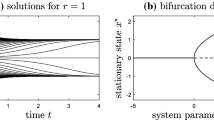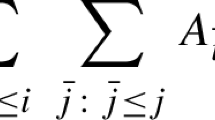Abstract
Using linear stability analysis, the qualitative stability properties of open nonlinear chemical systems, in which reactions of any order may occur, will be studied. Systems will be classified in three fundamental classes: trees, cycles and loops, according to their knot graphs. The study of the Jacobian matrix for the kinetic equations of the system shows that the symmetrizability by a particular procedure (calledD-symmetrizability) is a sufficient condition for stability. It has been proved that tree-graphs always satisfy the above condition. For the cycle-graphs, theD-symmetrizability condition leads to a cyclic relation between forward and reverse steady state flows. The stability may be assured, even if the cyclic relation is not satisfied, providing that the “symmetry breaking” be lower than an upper bound; further alternative criteria for stability of cycles have been derived. All these results are independent of the number of diffusive exchanges with the environment.
Similar content being viewed by others
Literature
Barnett, S. 1971.Matrices in Control Theory. London: Van Nostrand Reinhold.
Clarke, L. B. 1976a. “Stability of the Bromate-Cerium-Malonic Acid Network: I. Theoretical Formulation.”J. Chem. Phys. 64, 4165–4178.
—, 1976b. “Stability of the Bromate-Cerium-Malonic Acid Network: II. Steady-state Formic Acid Case.”J. Chem. Phys. 64, 4179–4191. (These articles also contain references to earlier contributions to the graph theoretic method by Clarke, B. L.)
Clarke, L. B. 1979. “Quasi-Thermodynamic Tree-Graph Networks.” Preprint.
Delattre, P. 1971.L'evolution des Systèmes Moléculaires. Bases Théoretiques. Applications à la Chimie et à la Biologie. Paris: Maloine.
Feinberg, M. and F. J. M. Horn. 1974. “Dynamics of Open Chemical Systems and the Algebraic Structure of the Underlying Reaction Networks.”Chem. Engng. Sci.,29, 775–787.
Glass, L. 1975a. “Classification of Biological Networks by Their Qualitative Dynamics.”J. Theor. Biol. 54, 85–107.
— 1975b. “Combinatorial and Topological Methods in Nonlinear Chemical Kinetics.”J. Chem. Phys. 63, 1325–1335.
— and A. S. Kauffman. 1973. “The Logical Analysis of Continuous Nonlinear Biochemical Control Network.”J. Theor. Biol. 39, 103–129.
Harary, F. 1972.Graph Theory. Reading, Mass.: Addison-Wesley.
Hearon, J. Z., 1953. “The Kinetics of Linear System with Special Reference to Periodic Reactions.”Bull. Math. Biophys.,15, 121–141.
— 1963. “Theorems on Linear System.”Ann. N. Y. Acad. Sci.,108, 36–68.
Horn, F. J. M. 1973a. “On a Connection Between Stability and Graphs in Chemical Kinetics: I. Stability and the Reaction Diagram.”Proc. Roy. Soc. Lond., A,334, 299–312.
— 1973b. “On a Connection Between Stability and Graphs in Chemical Kinetics: II. Stability and the Complex Graph.”Proc. Roy. Soc. Lond., A,334, 313–330.
— and R. Jackson. 1972. “General Mass Action Kinetics.”Arch. Ration. Mech. Anal.,47, 81–116.
Hyver, C. 1973. “Valeurs Propres des Systèmes de Transformation Répresentables par des Graphes en Arbres.”J. Theor. Biol.,42, 397–409.
Lehnigk, S. H. 1966.Stability for Linear Motions. Englewood Cliffs, N.J., Prentice Hall.
Sinano glu, O. 1975. “Theory of Chemical Reaction Networks. All Possible Mechanisms or Synthetic Pathways with Given Number of Reaction Steps or Species.”J. Am. Chem. Soc.,97, 2309–2320.
Solimano, F. and E. Beretta. 1976. “Tree Graphs Theory for Enzymatic Reactions.”J. Theor. Biol.,59, 159–166.
—— and E. Piatti. 1977. “The Tree Graphs Theory for Enzymatic Reactions: a Theorem for the Reactions Among the Non-Enzymatic Species.”J. Theor. Biol.,64, 401–412.
Author information
Authors and Affiliations
Rights and permissions
About this article
Cite this article
Beretta, E., Vetrano, F., Solimano, F. et al. Some results about nonlinear chemical systems represented by trees and cycles. Bltn Mathcal Biology 41, 641–664 (1979). https://doi.org/10.1007/BF02462420
Received:
Revised:
Issue Date:
DOI: https://doi.org/10.1007/BF02462420




